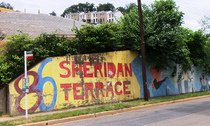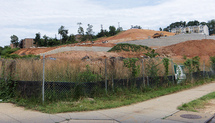Ward 8 development founders, may lose $4 million in grants
In 2007, the federal government awarded a $20 million HOPE VI grant to redevelop the site of the former Sheridan Terrace public housing project in Southeast. Since the first phase of rental and market units came online in December, the situation has taken a turn for the worse.
“We’re having an appraisal problem,” said Chris Evert of William C. Smith, the lead developer, at ANC 8A’s meeting earlier this week. “We’re nowhere close to being able to meet our market target pricing.”
Due to mounting difficulties in selling market units at the rebranded Sheridan Station, William C. Smith is proposing to drastically alter the remaining phases of its development plan. But if the Zoning Commission denies those changes, the developer would have to give $4 million in unspent grant money back to the federal government.
The consolidated Planned Unit Development (PUD) map amendment that the developers are seeking would make some major changes to Sheridan Station. Originally, 53% of the 344 total units were to be renter occupied. Now the developers want to increase rentals to 75% of the total, while reducing the number of dwellings to 327.
Members of the community and ANC 8A commissioners, whose position is given “great weight” when the modification comes before the Zoning Commission, were outspoken in their opposition to these changes at last week’s meeting.
“We can do that land bank strategy,” said Matt Engle of William C. Smith. Although, this waiting game strategy could allow time for the market to come back around, there’s a major caveat. If the $4 million does go back to the Treasury, the redevelopment’s completion could be compromised.
“The housing authority struggled with this change,” said Asmara Habte of the DC Housing Authority. “We did our own market research and we saw there just isn’t a market to develop any more home ownership units.”
Units priced at $328,000 and above are being appraised at just over $300,000. Complicating matters, said William C. Smith representatives, are the problems in nearby Henson Ridge, a HOPE VI project located on Alabama Avenue SE. Bank lenders have pointed to a recent short sale in Henson Ridge for $240,000 as a comparative sale that should guide Sheridan’s price points.
“The banks are schizophrenic,” Engle said.
As funding dries up nationwide for affordable housing programs and more than 40,000 people sit on the city’s waiting lists for housing assistance, the demand for help greatly overwhelms the supply.
However, residents believe the dense concentration of public housing in Ward 8 is handcuffing economic development, by suppressing property values.
“We always accept, ‘Well, we got to have a place to house people. We got to make the rents suitable for people,’” said Gregg Justice of ANC8A. “What about the people that are coming in the future?”
William C. Smith has been widely lauded by city officials as a responsible corporate citizen in Ward 8 for, among other projects, their development of THEARC on Mississippi Avenue. But some lifelong Anacostians said their initial skepticism is being confirmed.
Pointing to Sheridan Station’s misleading website that heralds, “Steps away from Metro and trolley,” Rev. Oliver Johnson, a former board member of the Anacostia Economic Development Corporation and Union Temple Community Development Corporation, says, “This dream has turned into a scheme that has turned into a nightmare.”
The problems at Sheridan Station, within an area the city’s branding as “CHASE” (Congress Heights, Anacostia, Saint Elizabeths), directly east of Sheridan Road, bound by Howard Road, Sayles Place, Bowen
Road, Stanton Road, and Pomeroy Road will without a doubt have a reverberating impact on the nearby commercial corridor that has seen the recent closure of two eateries.
Last summer Carol Chatham, Vice President of Communications for William C. Smith, said, “Many eyes are watching the Sheridan project. Success at Sheridan will encourage further development along the MLK corridor.”
What the potential failure of Sheridan Station means for the surrounding neighborhoods and greater Ward 8 is analogous to a modernized version of Charles Dickens’ epoch “Tale of Two Cities.”
The risk is that the city’s population continues to swell, while Ward 8 shrinks. New restaurants, businesses, and opportunities for leisure enliven communities elsewhere in the city, but Anacostia and Ward 8 remain a commercial dead zone.
Unless something starts to change, East of the River, foreclosures and short sales will continue to be ubiquitous. And deserted 19th century homes will continue to decay as the elements slowly turn history to dust.
There is no new Ward 8. It’s just more of the same old song; concentrated poverty, failing schools, and broken promises.


